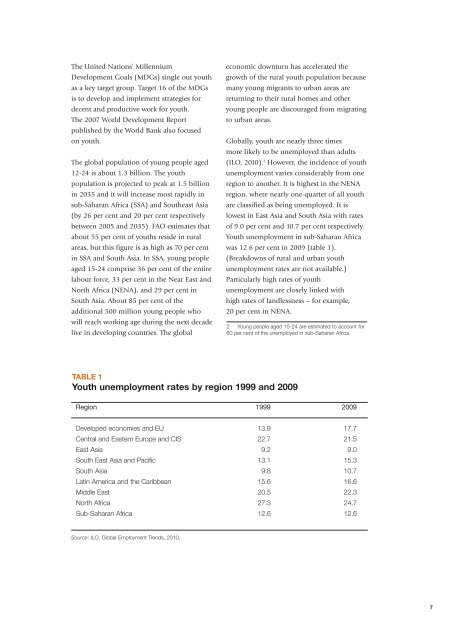Promoting livelihood opportunities for rural youth - IFAD
Promoting livelihood opportunities for rural youth - IFAD
Promoting livelihood opportunities for rural youth - IFAD
Create successful ePaper yourself
Turn your PDF publications into a flip-book with our unique Google optimized e-Paper software.
The United Nations’ Millennium<br />
Development Goals (MDGs) single out <strong>youth</strong><br />
as a key target group. Target 16 of the MDGs<br />
is to develop and implement strategies <strong>for</strong><br />
decent and productive work <strong>for</strong> <strong>youth</strong>.<br />
The 2007 World Development Report<br />
published by the World Bank also focused<br />
on <strong>youth</strong>.<br />
The global population of young people aged<br />
12-24 is about 1.3 billion. The <strong>youth</strong><br />
population is projected to peak at 1.5 billion<br />
in 2035 and it will increase most rapidly in<br />
sub-Saharan Africa (SSA) and Southeast Asia<br />
(by 26 per cent and 20 per cent respectively<br />
between 2005 and 2035). FAO estimates that<br />
about 55 per cent of <strong>youth</strong>s reside in <strong>rural</strong><br />
areas, but this figure is as high as 70 per cent<br />
in SSA and South Asia. In SSA, young people<br />
aged 15-24 comprise 36 per cent of the entire<br />
labour <strong>for</strong>ce, 33 per cent in the Near East and<br />
North Africa (NENA), and 29 per cent in<br />
South Asia. About 85 per cent of the<br />
additional 500 million young people who<br />
will reach working age during the next decade<br />
live in developing countries. The global<br />
economic downturn has accelerated the<br />
growth of the <strong>rural</strong> <strong>youth</strong> population because<br />
many young migrants to urban areas are<br />
returning to their <strong>rural</strong> homes and other<br />
young people are discouraged from migrating<br />
to urban areas.<br />
Globally, <strong>youth</strong> are nearly three times<br />
more likely to be unemployed than adults<br />
(ILO, 2010). 2 However, the incidence of <strong>youth</strong><br />
unemployment varies considerably from one<br />
region to another. It is highest in the NENA<br />
region, where nearly one-quarter of all <strong>youth</strong><br />
are classified as being unemployed. It is<br />
lowest in East Asia and South Asia with rates<br />
of 9.0 per cent and 10.7 per cent respectively.<br />
Youth unemployment in sub-Saharan Africa<br />
was 12.6 per cent in 2009 (table 1).<br />
(Breakdowns of <strong>rural</strong> and urban <strong>youth</strong><br />
unemployment rates are not available.)<br />
Particularly high rates of <strong>youth</strong><br />
unemployment are closely linked with<br />
high rates of landlessness – <strong>for</strong> example,<br />
20 per cent in NENA.<br />
2 Young people aged 15-24 are estimated to account <strong>for</strong><br />
60 per cent of the unemployed in sub-Saharan Africa.<br />
TABLE 1<br />
Youth unemployment rates by region 1999 and 2009<br />
Region 1999 2009<br />
Developed economies and EU 13.9 17.7<br />
Central and Eastern Europe and CIS 22.7 21.5<br />
East Asia 9.2 9.0<br />
South East Asia and Pacific 13.1 15.3<br />
South Asia 9.8 10.7<br />
Latin America and the Caribbean 15.6 16.6<br />
Middle East 20.5 22.3<br />
North Africa 27.3 24.7<br />
Sub-Saharan Africa 12.6 12.6<br />
Source: ILO, Global Employment Trends, 2010.<br />
7

















